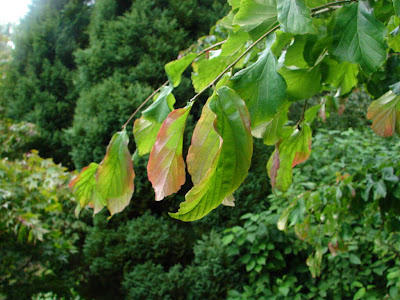
Common Elm (Ulmus procera) is now a rare tree in many parts of the country so it was pleasing to find one that had survived in the staff car park. (See Comment below!)

Fastigate Hornbeam (Carpinus betulus pyramidalis).


The light was really poor for taking photos of trees but at least the absence of the sun meant that the angle didn't matter since one was never against the sun. This is a Monterey Pine (Pinus radiata).

In The Plantation there were some beautiful Hart's Tongue Ferns.


Most of the trees in The Plantation are not named - either on the ground or in the book. I was attracted to this small tree by the half-eaten fruits on the ground - presumably the work of the Grey Squirrels who could be seen scampering around.

The bark of an exotic Birch species.

Helen has a wonderful photo of the leaves of this tree by the pond on North Park Road. Unfortunately I am still unable to identify it.

A lot of the plants were covered in dewy cobwebs.

This sculpture on the side of the Peter Chalk Centre is called the Minoprio Fountain after its architect Anthony Minoprio who donated it to the University as part of his work to encourage water sculptures in public settings.

This a Nikko Fir (Abies homolepis).


A number of cones were beneath both it and an adjacent pine but were totally unrecognisable after the Squirrels had been at them.

An immature Gull was amongst the birdlife of the university gardens.

A scruffy moulting Magpie was also there.

Barbara Hepwrth's sculpture "Figure for Landscape".

Wild Radish in a newly sown lawn.


This subspecies of the Spanish Oak is known as the Exeter Oak (Quercus x hispanica lucombiana).
The unnamed small trees appear to be camellias - there are masses of them at Exeter University - and the other shrub / tree with large leaves that turn spectacularly colourful in autumn looks like a parrotia persica.
ReplyDeleteCame across your blog when looking for pictures of pinus radiata - very handy.
All the best
Roger
Thanks Roger - my daughter will be pleased to have the name of the Parrotia persica if she doesn't already know it.
ReplyDeleteFirst photo was also a Hornbeam (Carpinus sp.), not Elm. Those structures are little nutlets attached to bracts, all in a pendulous cluster.
ReplyDeleteIt would be helpful if anonymous commenters could quote their qualifications / authority / sources. Otherwise I have no way of knowing if their knowledge is any greater than mine.
ReplyDelete